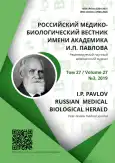Physiological ‘cost’ of activity of individuals with different effectiveness in dynamics of endosurgical training
- Authors: Klimenko A.V.1, Pertsov S.S.1,2, Yakovenko I.Y.2, Levkin E.I.1, Samratov T.U.1, Gubenko M.S.1
-
Affiliations:
- A.I. Evdokimov Moscow State University of Medicine and Dentistry
- P.K. Anokhin Research Institute of Normal Physiology
- Issue: Vol 27, No 3 (2019)
- Pages: 333-341
- Section: Original study
- URL: https://journals.rcsi.science/pavlovj/article/view/16341
- DOI: https://doi.org/10.23888/PAVLOVJ2019273333-341
- ID: 16341
Cite item
Abstract
Aim. The work was designed to study the physiological ‘cost’ of purposeful behavior on the model of endosurgical training.
Materials and Methods. The research was implemented on 87 men of 18-24 years of age. The volunteers per formed a number of exercises 30 minutes each according to the Basic Endosurgical Simulation Training and Attestation System (BESTA system) on a T5 Large RM box-trainer within 10 consecutive days. The total time and the number of mistakes were recorded. During the training sessions an electromyogram was recorded on a BIOPAC MP 36 device. ECG was recorded and processed using a Varicard 2.51 device before and after the training sessions. ECG was analyzed by evaluation of the average differences of spectral analysis of heart rate variability before and after training.
Results. It was shown that high-performance individuals were characterized by less energy spent on motor work in purposeful activity. Irrespective of the effectiveness of training, the purposeful behavior in conditions of psychoemotional stress was characterized by depletion of functional reserves of an organism. Low-performance subjects demonstrated a more evident weakening of parasympathetic (start of observations) and of sympathetic influences (end of observations) on the functional activity of the heart.
Conclusion. Specific features of physiological ‘cost’ of purposeful behavior in individuals with different effectiveness of the activity were revealed on the model of endosurgical training. Better results in the dynamics of purposeful activity were achieved on this model at a higher physiological ‘cost’.
Full Text
##article.viewOnOriginalSite##About the authors
Aleksey V. Klimenko
A.I. Evdokimov Moscow State University of Medicine and Dentistry
Author for correspondence.
Email: solidcid@mail.ru
ORCID iD: 0000-0002-0488-7871
SPIN-code: 7207-5189
Assistant of the Department of Common Surgery
Russian Federation, MoscowSergey S. Pertsov
A.I. Evdokimov Moscow State University of Medicine and Dentistry; P.K. Anokhin Research Institute of Normal Physiology
Email: solidcid@mail.ru
ORCID iD: 0000-0001-5530-4990
SPIN-code: 3876-0513
ResearcherId: A-6697-2017
MD, PhD, Professor, Corresponding Member of RAS, Deputy Director for Science, Head of the Laboratory of System Mechanisms for Emotional Stress; Head of the Department of Normal Physiology and Medical Physics
Russian Federation, MoscowIgor. Yu. Yakovenko
P.K. Anokhin Research Institute of Normal Physiology
Email: solidcid@mail.ru
ORCID iD: 0000-0003-2082-7171
SPIN-code: 3111-8971
MD, PhD, Professor, Head of the Department of Common Surgery
Russian Federation, MoscowEugene I. Levkin
A.I. Evdokimov Moscow State University of Medicine and Dentistry
Email: solidcid@mail.ru
ORCID iD: 0000-0003-0119-1673
SPIN-code: 3474-5034
MD, PhD, Associate Professor of the Department of Common Surgery
Russian Federation, MoscowTimur U. Samratov
A.I. Evdokimov Moscow State University of Medicine and Dentistry
Email: solidcid@mail.ru
ORCID iD: 0000-0001-6994-7188
SPIN-code: 5864-9418
MD, PhD, Assistant of the Department of Common Surgery
Russian Federation, MoscowMarina S. Gubenko
A.I. Evdokimov Moscow State University of Medicine and Dentistry
Email: solidcid@mail.ru
ORCID iD: 0000-0001-5439-9713
Student of the Department of Medical Faculty
Russian Federation, MoscowReferences
- Anokhin PK. Izbrannyye trudy: Kibernetika funktsional’nykh sistem. Moscow: Meditsina; 1998. (In Russ).
- Sudakov KV, Umryukhin PE. Sistemnye osnovy emotsional’nogo stressa. Moscow: GEOTAR-Media; 2010. (In Russ).
- Lapkin MM. Individual'nye osobennosti zhivotnykh i cheloveka v sistemnoy organizatsii tselenaprav-lennogo povedeniya. VI Pavlovskiye nauchnyye chteniya, posvyashchennyye 160-letiyu so dnya rozhdeniya I.P. Pavlova. Ryazan; 2009. P. 21-39. (In Russ).
- Medelyanovskiy AN. Funktsional’nye sistemy obespechivayushchiye gomeostaz. Funktsional’nye sistemy organizma. Moscow: Meditsina; 1987. P. 77-103. (In Russ).
- Zorin RA, Lapkin MM, Trutneva EA, et al. Physiological Costs Can Predict Effectiveness of Cognitive Activity. Doctor.Ru. 2012;10(78):24-8. (In Russ).
- Dzhebrailova TD, Sulejmanova RG, Ivanova LI, et al. Physiological Processes Underlying Purposeful Activity in the Students During Computer Testing. Journal of New Medical Technologies. 2013;XX(1): 38-42. (In Russ).
- Lila NL, Sudakov SK. Method for Studies of Orientation and Exploratory Behavior in Humans. Effects of Emotional Stress. Bulletin of Experimental Biology and Medicine. 2018;165(3):394-6. (In Russ).
- Fudin NA, Vagin YuE. Sports activity in functional systems theory. Sechenov Medical Journal. 2016; 3(25):34-45. (In Russ).
- Gorshkov MD, Sovtsov SA., Matveyev NL. BESTA, kurs bazovogo endokhirurgicheskogo simulyatsion-nogo treninga i attestatsii. Al'manakh instituta khirurgii im. A.V. Vishnevskogo. 2017;(S1):600-1. (In Russ).
- Simulyatsionnoye obucheniye bazovym navykam v endokhirurgii. Simulyatsionnyy trening po maloinvazivnoy khirurgii: laparoskopiya, endosko-piya, ginekologiya, travmatologiya-ortopediya i artroskopiya. Moscow: ROSOMED; 2017. P. 71-132. (In Russ).
- Hogle NJ, Liu Y, Ogden RT, et al. Evaluation of surgical fellows' laparoscopic performance using Global Operative Assessment of Laparoscopic Skills (GOALS). Surgical Endoscopy. 2014;28(4):1284-90. doi: 10.1007/s00464-013-3324-6
- Sloan DA, Donnelly MB, Schwartz RW, et al. The Objective Structured Clinical Examination. The New Gold Standard for Evaluating Postgraduate Clinical Performance. Annals of Surgery. 1995; 222(6):735-42.
- Dimirtiev DA, Saperova EV. Heart rate variability and blood pressure during mental stress. Russian journal of physiology (formerly I.M. Sechenov Physiological Journal). 2015;101(1):98-107. (In Russ).
- Kotel'nikov SA, Nozdrachev AD, Odinak MM, et al. Variabel'nost' ritma serdtsa: predstavleniya o mekhanizmakh. Fiziologiya cheloveka. 2002; 8(1): 130-43. (In Russ).
- Heart rate variability. Standards of Measurement. Physiological Interpretation and Clinical Use. Task Force of the European Society of Cardiology and the North American Society of Pacing and Electrophysiology. Circulation. 1996;5(93):1043-65.
- Babunts IV, Miridzhanyan EM, Mashayekh YuA. Azbuka analiza variabel'nosti serdechnogo ritma. Stavropol: Printmaster; 2002. (In Russ).
- Lutsevich OE, Rubanov VA, Tolstykh MP, et al. Faktory, vliyayushchiye na skorost' formirovaniya bazovykh manual'nykh navykov v laparosko-picheskoy khirurgii. Moskovskiy khirurgicheskiy zhurnal. 2017;3(55):47-53. (In Russ).
Supplementary files







